Table of Contents
Kuhli Loach: A Brief Introduction
Kuhli loaches are small, slender fish native to Southeast Asia. They are popular in the aquarium trade for their attractive, striped appearance and peaceful nature. They are a nocturnal species and do well in groups, making them a good choice for community tanks.
They are known to be sensitive to poor water quality, so proper care and maintenance of the tank is important.
Kuhli Loach Overview
Kuhli Loach or ‘Pangio Kujlii’ is a small, very active fish with behavior specific to members of the Pangio genus. It is almost always moving, swimming around in plants or ornaments. Kuhli Loach is a fish that continuously goes after unspoiled food scraps that have fallen on the bottom of the aquarium. They are a real asset in keeping the cleanliness in the aquarium. Kuhli Loaches are one of the best bottom-feeder fish.
This small fish was originally called Kuhli Loach or Prickly Eye, but there are also some familiar names: Coolie Loach, Leopard Loach, Cinnamon Loach. Kuhli Loach is a famous export to thousands of countries of origin for aquarists around the world.
The term ‘Kuhli Loach’ is a generic name for a fish group of the genus Pangio. A snake-like shape characterizes these fish, they are of the same size and appearance, and all are hardworking, but each has distinct features (such as size, color) that differentiate them from the Kuhli.
| Information Chart | Kuhli Loach |
| Scientific Name: | Pangio kuhlii |
| Family: | Cobitidae |
| Care Level: | Easy to intermediate |
| Temperament: | Peaceful |
| Color: | Yellow with brown bands |
| Lifespan: | Up to 10 years |
| Size: | Up to 4 inches |
| Diet: | Omnivorous |
| Minimum Tank Size: | 20 gallons |
| Temperature: | 73 to 86 degrees F |
| WaterConditions: | 0-5 GH, pH 5.5 to 6.5 |
| Tank Mate Compatibility | Peaceful community |
Kuhli Loach Appearance

The body of a Kuhli Loach is yellow, with a pink iris. There are 12-17 vertical bars, of which 3 bars are on the head. It does not have scales on the head. A transparent membrane covers the eyes of a Kuhli Loach. They have a short spin in the front, and the muzzle has three pairs of mustaches like the rods. The dorsal fin is at the very back, as is anal flipping.
There is also an albino form of this species, known as Albino Kuhli Loach. It is an artificially obtained variety, and it is unknown whether it exists in the natural environment. If it existed, it would undoubtedly be an easy target for predators.
The Lifespan of Kuhli Loach
The typical lifespan of a Kuhli Loach is ten years in captivity. Kuhli Loaches live in large groups, and this increases their chances of survival. Of course, with optimum water conditions and care, they will live healthily for up to 10 years.
Kuhli Loach Size
The typical Kuhli Loach grows to 2.5 to 3 inches on the lower end and 5 inches for larger specimens. The average size they do reach in a tank is around 3 inches.
Natural Habitat and Origin
The Kuhli Loach, also called the Acanthophthalmus Kuhlii, was described in 1846 by Valenciennes. They were discovered in Southern Asia: Sumatra, Singapore, Malaysia, Java, Borneo, and Thailand. In the wild, the fish live in sandy areas of some rivers, covered with leaf beds. The forests permanently overshadow their typical habitat. They are found in small groups, although they are not card fishes. The water they live in resembles a swampy pond, thick with vegetation and black-ish water. The river
Kuhli Loach Care & Tank Set-Up
Kuhli Loach Tank Size and Specifications

Optimum Tank Size for Kuhli Loach
The recommended tank size for Kuhli Loach is 20 gallons or 24 x 12 x 16 (H). Of course, the bigger the tank, the more space they will have. You should go in for a bigger tank if you can get it so that they have plenty of places to hide. They are shoaling fish, so keep at least 6 to 8 of them together.
Tank Shape for Kuhli Loach
Kuhli Loaches need enough space to sleep and hide. Any tank that is smaller than 20 gallons will be too cramped for them. Also, remember to get a tank with a lid as Kuhli Loaches might try and jump out of the tank if they feel threatened.
Filter Type
Kuhli Loaches are sensitive to water changes and temperature. Using an under gravel filter will be the best option for you as they prefer a good amount of water movement. Regardless of whichever filter you use, you will need to cover the outlet and the pipe as many a times Loaches might get trapped inside them and die.
Substrate
The substrate should be as fine as possible to avoid the wreckage and to hide the fish. In the wild, they scoop up pieces of the substrate to look for eatables. If the substrate is large, you can arrange a small amount of sand to serve as a shelter for the Kuhli Loach. When they feel threatened, they sink into the substrate or retreat to their favorite hiding places.
How many Kuhli Loach can you keep in a 20-gallon tank?
The ideal number of Kuhli Loaches in a 20-gallon tank should be no more than 4 to 6 because they will need plenty of hiding space. Plus, your tank will be thickly planted, further reducing the space available to the fish. We recommend always considering getting a bigger tank size.
Water Parameters for Kuhli Loach
Water Temperature
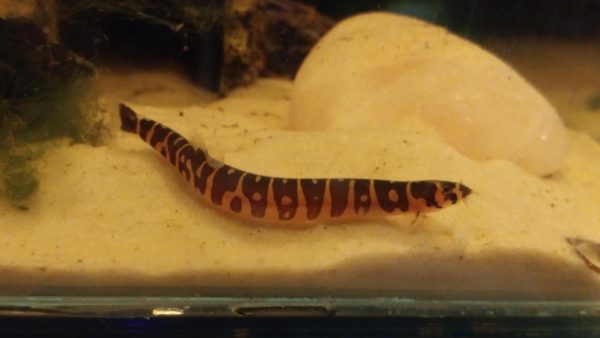
The ideal water temperature for Kuhli Loach is 73 to 86 degrees F. They need waters with a slightly cold temperature. Make sure that you do not cross this range as it will impact their health adversely.
Water Flow Rate
In the wild, Kuhli Loaches live in slow-moving waters. Try to replicate this in your tank too.
pH Level
The perfect water pH level for a Kuhli Loach tank is 5.5 to 6.5. Kuhli Loaches like living in slightly acidic water, so make sure that this pH is maintained even during the water changes.
Most important for the Kuhli Loaches is clean and well-hydrogenated water. Partial water exchange, 30% per week, through suction of the substrate, is necessary. It is not advisable to strictly clean the decors and stones because the biofilm contained therein can be helpful in the nitrogen cycle of the fish.
Kuhli Loach Tank Landscape
To make sure that Kuhli Loaches are happy in their tank, remember to have a lot of algae growth in the tank. Remember that Kuhli Loaches are nocturnal and might jump out of the tank if they feel threatened, so a tank lid is a must. Here are some more tips to decorate and set up the perfect tank for these fish:
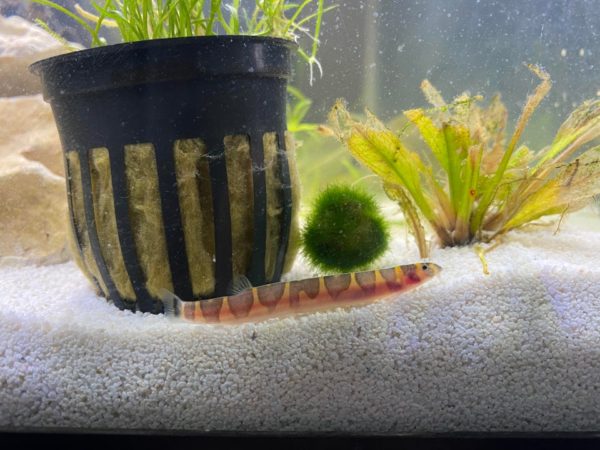
Best Plants for Kuhli Loach Tanks
Kuhli Loaches will appreciate heavily planted aquariums as it replicates their natural environment best. Using plants such as Cryptocoryne, Java Fern, Anubias, Marsilea Hirsuta, and Java Moss will give shelter and a safe place for your Kuhli Loaches.
Worst Plants for Kuhli Loach Tanks
You should avoid plants with large, spindly mops as they leave very little space for the fish to roam in the tank. Also, avoid the plants that cannot grow on a sandy substrate or restrict the fish’s movement.
Decorations for Kuhli Loach Tanks
The key to recreating the natural habitat for Kuhli Loaches is to have a natural tank setup. Rocks are the best decoration for a Kuhli Loach tank as it gives them room to jump around. Try to recreate a coral reef environment by adding live rocks and pieces of driftwood. Position them in a way that gives them space to hide inside.
Lighting for Kuhli Loach Tanks
There is no need for extra lighting for a Kuhli Loach tank. They are used to hiding under the cover of rocks and plants. But since they are nocturnal creatures, you might have difficulty spotting them. You can add a dim blue or red light to the tank for this purpose.
Feeding Kuhli Loach
Best Diet for Kuhli Loach
In the wild, Kuhli Loaches feed on larvae of insects, microorganisms, and small crustaceans. Kuhli Loaches will accept dry food, live or frozen Daphnia, Artemia, worms, Grindal, and wafers or flake foods in the aquarium.
Since Kuhli Loaches are omnivores, they will consume any live or frozen food or meat. They also like sinking flakes, tablets, flakes, or vegetable-based food. To change their diet regularly, you can also serve them the other food with tubifex, worms, salt shrimps, flies, or daphnia larvae.
Remember that sinking food is a must for Kuhli Loach tanks because they are bottom-dwelling fish, and the food must reach them. Especially if you have top-dwelling fish in the tank, keep an eye to make sure enough food reaches the bottom.
How often should you feed Kuhli Loach?
Kuhli Loach should typically be fed 2 or 3 times per day, at night. To ensure that they are getting a well-balanced diet, change the dry foods with live or frozen food a few days a week. Also, remember only to feed them the food that they can consume within 2 or 3 minutes.
Kuhli Loach Behaviour and Temperament
Kuhli is a peaceful and peaceful fish with predominantly nocturnal activity. There are shy fishes, and if there is only a single fish in the tank, it will remain hidden all the time. That does not mean they are card fishes, but they just feel more comfortable and will be more confident of getting out of the hiding place in the presence of other people.
Is Kuhli Loach lone or societal?
Kuhli Loach is a shoaling fish and feels the most comfortable in a large group. They are shy, nocturnal creatures, and you might not even see them most days. They hide in crevices and under the plants all day long. When they do come out, they do not interact much with other companions.
Kuhli Loach spends most of their time at night scavenging the bottom soil or substrate for hidden food. They will appreciate a lot of hiding places in the tank, too. When they feel threatened, they tend to hide instead of fighting.
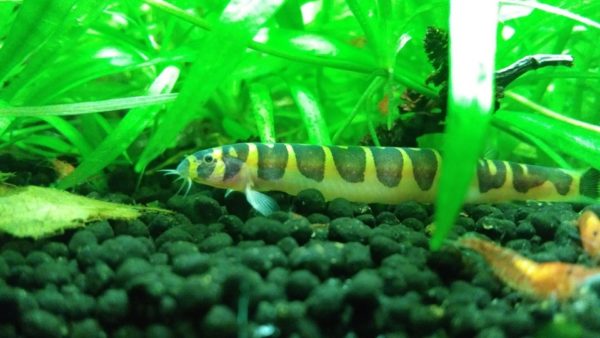
Their non-confrontational nature makes them perfect for peaceful community tanks. They will do incredibly well with other top dwellers.
Kuhli Loach Tank Mates
Ideal Kuhli Loach Tank Mates
Kuhli Loaches are a shoaling species. It is a great idea to keep them in a mixed tank with other peaceful community fish.
There are many fish species that Kuhli Loaches will live with peacefully. The following species of fish will be ideal tank mates for a Kuhli Loach tank:
- Danio (Zebra Danio and Pearl Danio)
- Tetra (especially with Neon Tetra and Black Tetra)
- Guppy, Platty, Gourami (Blue Gourami, Dwarf Gourami, Honey Gourami)
- Discus, Apistogramma (Apistogramma Cacatouides and Apistogramma Borelli)
- Corydoras Catfish (especially Corydoras Sterbai and Corydoras Aeneus) Angelfish, Clown Loach)
- Chili Rasboras
- Badis Badis
- Cherry barb
- Bristlenose Pleco
- Nerite Snail
- Mystery Snail
- Rabbit snails
- Assassin snails
Bad Tank Mates for Kuhli Loach
You should avoid any large fish species for a Kuhli Loach tank. Kuhli Loaches are very small, and they hide when they feel threatened. For this reason, Also, you should avoid some species such as the following:
- Cichlids (like angelfish)
- Pacus
- Shovelnose catfish
- Redtail catfish
- Gar
- Goldfish
Breeding Kuhli Loach
Kuhli Loaches are a tricky species to breed. Kuhli Loaches will be sexually mature when they are two years old, so you will have to be patient with them. But, if you are confident of your chances, give it a try with the following instructions.
A separate breeding tank is required to breed the Kuhli in captivity. Using a 10 to 20-gallon tank is the best size to try and keep four breeding pairs together. To create a perfect breeding environment, keep the lighting very dull, and maintain a low water level.
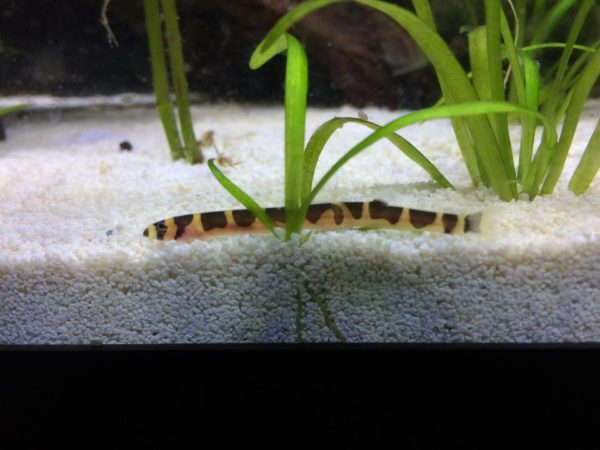
The females will use the floating plants around the tank to lay their eggs. Another technique to ensure breeding is to plant the breeding tank densely. The dense vegetation will also be helpful while laying eggs. The tank must also have a soft, sand substrate.
The water hardness during this time has to be lower than usual. You can maintain the pH at a steady 6 to 6.5. A slightly acidic and mostly neutral environment will promote spawning. Gradually raise the temperature to about 83 degrees F.
Kuhli Loaches always feel more comfortable around other Kuhlis. You can use the same logic during the breeding process. If other Kuhli Loaches surround them, they will spawn more. That is the reason why Kuhli Loaches are ‘communal spawners.’
During the breeding period, there should be a healthy diet fed to the breeding pairs. To prepare them and nourish them for spawning, make use of live food options.
Once the mating has successfully taken place, you will notice a difference in the size of the females. Females will grow more prominent, and you will see the eggs they are carrying through their skin. When the eggs are ready to hatch, females will release them in the dense vegetation. The eggs are green in color, and they stick to the underside of the plants in the tank.
Kuhli Loaches do not possess any paternal instincts and will try to feed on the eggs, so the speed is of the essence here. As soon as the eggs are released, separate the adults and the eggs.
The hatching period is relatively short. Fry will hatch out of the eggs in only 24 hours. In their earlier days, you can feed brine shrimp or infusoria to the fry. We also recommend using readily available commercial food for the fry.
Maintaining ideal water conditions will be very important for the fry to grow into fish. Make sure that you are changing the water of the breeding tank every day. The fry will take about six weeks or so to reach the size of one inch. After this, you will need to move them to a bigger tank.
The entire process is challenging until the end, as these fish do not breed that quickly in captivity.
Kuhli Loach Breeding Level – Hard
Kuhli Loach Sexual Dimorphism?
To distinguish between male and female Kuhli Loach, we must notice their body structure. Kuhli Loaches are a sexually dimorphic species, and there are noticeable differences between males and females. The body and the tail of the females are fatter. When the females are in the middle of spawning, their bodies appear more prominent, as we can see the eggs they carry through their translucent skin. Female Kuhlis also have the ends of their tails straight. Whereas for males, it is slightly bent.
Kuhli Loach Common Diseases and their Treatment
Kuhli Loaches are susceptible to disease because of their small size and the absence of head scales. This absence makes them sensitive to water temperature changes.
Kuhli Loaches will be affected by common illnesses, especially if the tank environment is not healthy. Some common diseases could be:
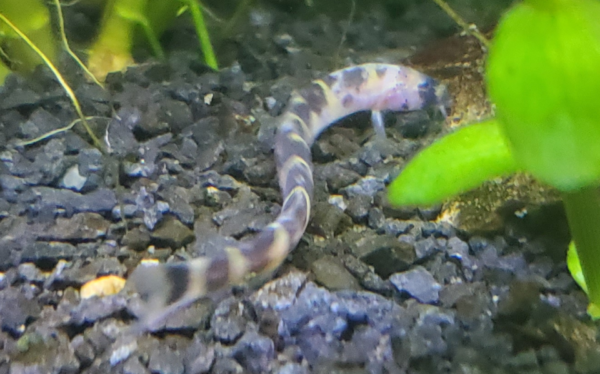
Ich or White Spot Disease
White Spot Disease causes respiratory problems in the fish. They will show restless behavior, but most importantly, white spots on the body of the fish. This disease will go away once you meet the ideal water conditions. Other symptoms will include lethargy, and the fish will stop eating. Since this is a common disease, you can also opt for over-the-counter medications to treat it quickly.
Parasitic infections
Parasitic infections are common in unclean water. If there is any debris left in the tank, it will cause bacteria which will contribute to these infections. The best thing to do is to isolate the affected fish and treat them first. If you maintain hygiene and care in the tank, these diseases will not occur.
Remember that they are scaleless fish, and that makes them extra sensitive to common medicines as well. Consult a professional before administering any medication to your Kuhli Loach tank because the dosage will work differently on them compared to other scaly fish. Apart from looking out for any common diseases, stress reduction, offering plentiful space to them, and providing a clean tank are the best things that you can do to care for your Kuhli Loach.
Facts about Kuhli Loach
- Kuhli Loaches are shy, tiny nocturnal fish species belonging to Indonesia and Malaysia.
- They are ‘scaleless fish’ because their scales are thin and spread apart, leaving them vulnerable.
- Their appearance looks like an eel (or a snake), but they are different from eels because they have pelvic fins.
- Kuhli Loaches are scavengers, and their main pastime is to scourge the tank for things to eat.
- In the wild, you can often find them in a group of 12 or more.
Are Kuhli Loach Right For You?
Authors Note: Keeping in good condition, these fish are powerful. However, they are also susceptible to the medication used as a treatment. They live and breed best in their native environment, so breeding should not be your number one goal if you get Kuhli Loaches.
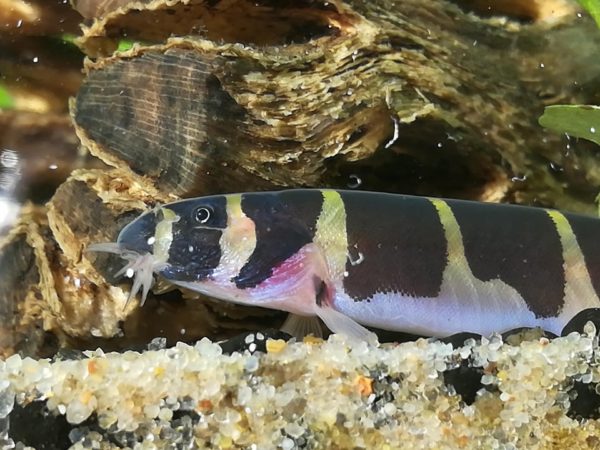
FAQs
How big do Kuhli Loaches get?
Kuhli Loaches rarely grow more than 4 inches. On average, most of them only grow up to 2.5 inches. This growth, of course, depends on the tank hygiene and diet of the fish.
Are Kuhli Loaches aggressive?
Their eel-like appearance might make them look aggressive, but they are very peace-loving. The fish hide behind and inside items most of their life and are not the bold type.
Will Kuhli Loaches jump out of their tanks?
Kuhli Loaches love jumping out of the water and can be hard to keep track of, especially at night (they only come out during this time!). We recommend tight-fitting the lid for any Kuli Loach tank.
Can Kuhli Loach live with Bettas?
Yes, Kuhli Loaches will live with Bettas peacefully. Bettas and Kuhli Loaches will leave each other alone as one is a top dwelling species while the other is a bottom-dwelling one.
Can Kuhli Loach live with Shrimp?
Yes, Kuhli Loaches will live with Shrimp. But, Kuhli Loaches can eat shrimps or baby shrimps, and it would not be advisable.
Do Kuhli Loaches eat algae wafers?
Algae wafers are a part of a Kuhli Loach diet. They will like eating them.
Conclusion
Kuhli Loaches are small fish and are quite shy creatures. This nocturnal freshwater species come alive during the night and are very sensitive to changes in water and pH. Kuhli Loaches are also a nifty tank cleaner without producing a lot of waste. They are very distinctive in appearance, and a group of Kuhli Loach will do wonders to any tank. If you are looking to breed them, then you might be disappointed. They require extra care and might not be suitable for someone just starting in the industry. However, with a little bit of patience, caring for them can become a rewarding experience.
No related posts.
